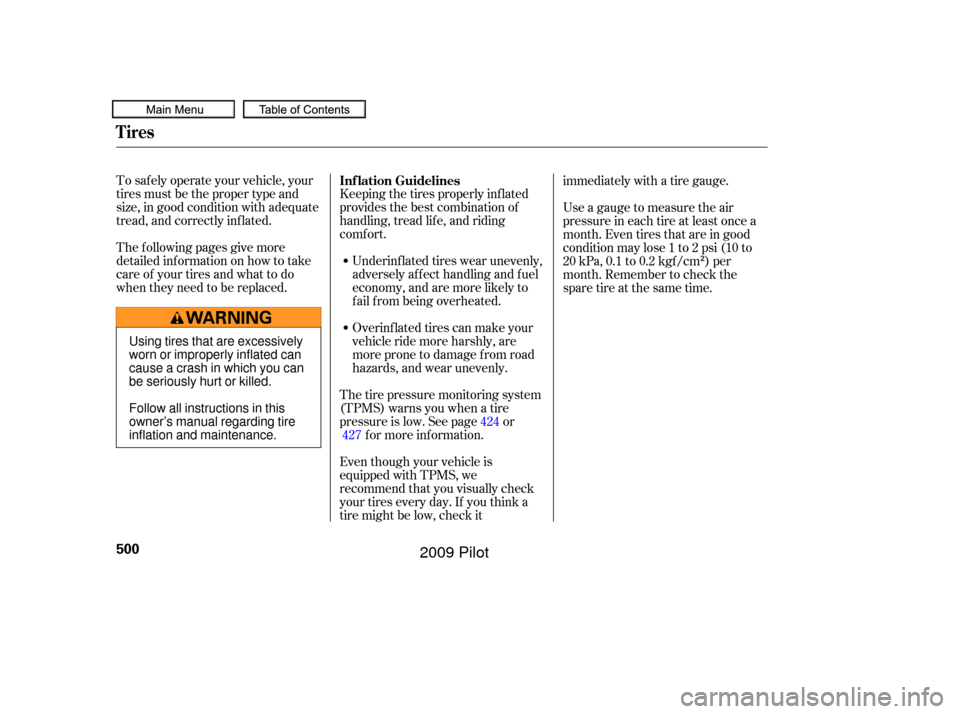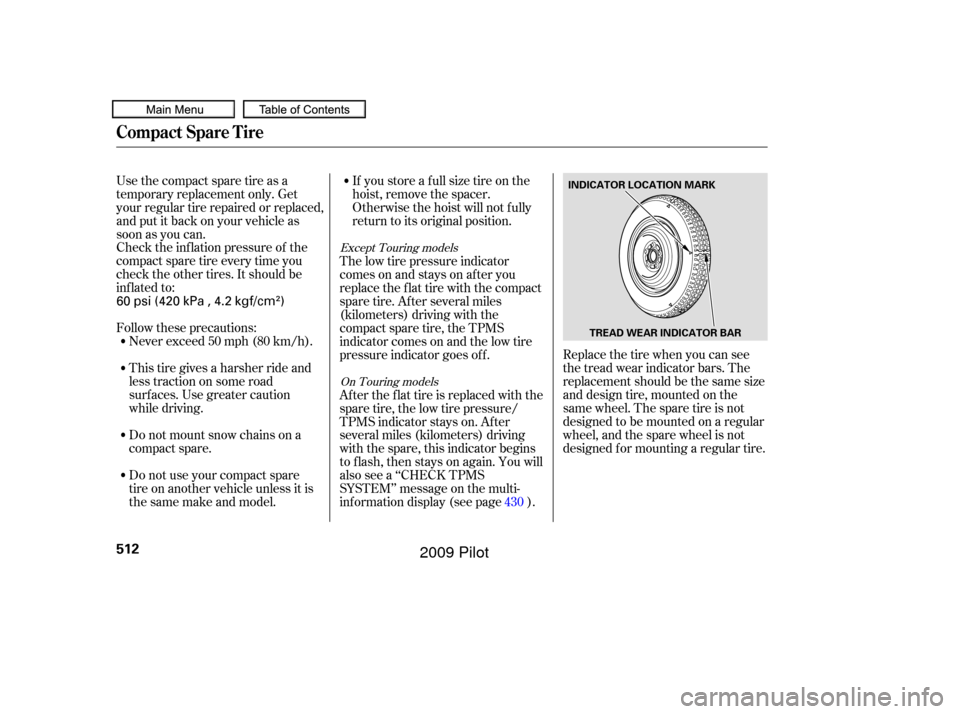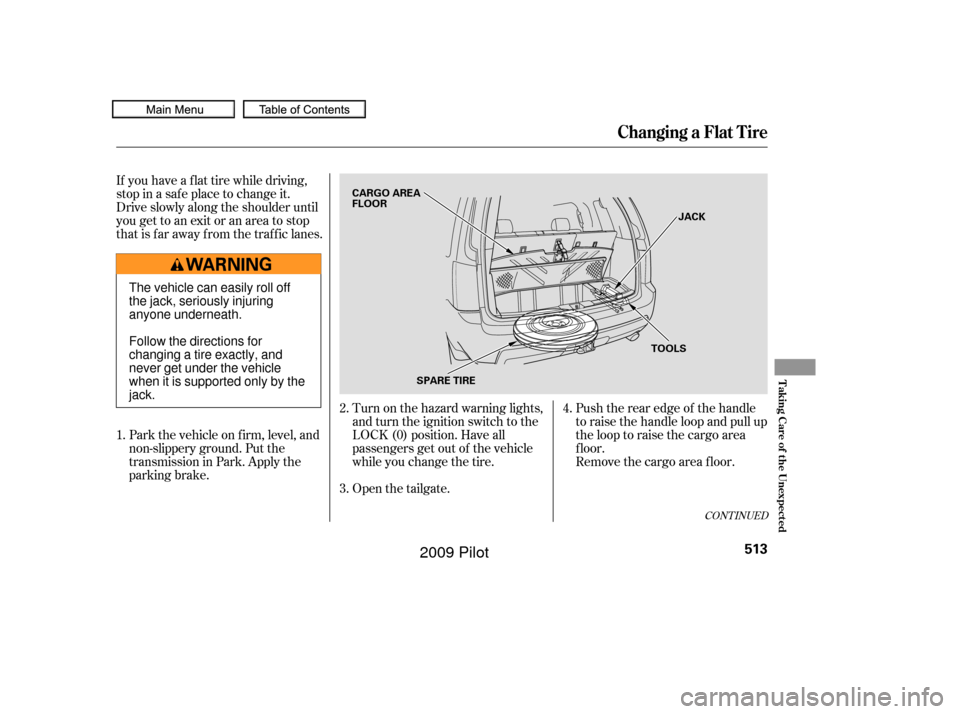Page 504 of 578

To saf ely operate your vehicle, your
tires must be the proper type and
size, in good condition with adequate
tread, and correctly inf lated.Keeping the tires properly inf lated
provides the best combination of
handling, tread lif e, and riding
comf ort.
The f ollowing pages give more
detailed inf ormation on how to take
care of your tires and what to do
when they need to be replaced. Underinf lated tires wear unevenly,
adversely affect handling and fuel
economy, and are more likely to
fail from being overheated.
Overinf lated tires can make your
vehicleridemoreharshly,are
more prone to damage f rom road
hazards, and wear unevenly.
Even though your vehicle is
equipped with TPMS, we
recommend that you visually check
your tires every day. If you think a
tire might be low, check it immediately with a tire gauge.
Use a gauge to measure the air
pressure in each tire at least once a
month. Even tires that are in good
condition may lose 1 to 2 psi (10 to
20 kPa, 0.1 to 0.2 kgf /cm ) per
month. Remember to check the
sparetireatthesametime.
Thetirepressuremonitoringsystem
(TPMS) warns you when a tire
pressure is low. See page or f or more inf ormation. 424
427
Inf lation Guidelines
Tires
500
Using tires that are excessively
worn or improperly inflated can
cause a crash in which you can
be seriously hurt or killed.
Follow all instructions in this
owner’s manual regarding tire
inflation and maintenance.
�����—�����—�
���y�
�������������y���
�(�/���������y���������y
2009 Pilot
Page 515 of 578

This section covers the more
common problems that motorists
experience with their vehicles. It
gives you inf ormation about how to
safely evaluate the problem and what
to do to correct it. If the problem has
stranded you on the side of the road,
you may be able to get going again.
If not, you will also f ind instructions
on getting your vehicle towed.......................
Compact Spare Tire .512
....................
Changing a Flat Tire .513
.............
If the Engine Won’t Start . 520
................................
Jump Starting .521
..............
If the Engine Overheats . 523
.........
Low Oil Pressure Indicator . 525
..........
Charging System Indicator . 525
.......
Malf unction Indicator Lamp . 526
...............
Brake System Indicator . 527
..............................................
Fuses .528
..............................
Fuse Locations .532
......................
Emergency Towing .535
..........
If Your Vehicle Gets Stuck . 536
Taking Care of the Unexpected
T aking Care of t he Unexpect ed
511
�����—�����—�
���y�
�������������y���
�(�/���������y�����
���y
2009 Pilot
Page 516 of 578

Check the inf lation pressure of the
compact spare tire every time you
check the other tires. It should be
inf lated to:
Follow these precautions:Never exceed 50 mph (80 km/h).
Do not mount snow chains on a
compact spare.
Do not use your compact spare
tire on another vehicle unless it is
thesamemakeandmodel.
Use the compact spare tire as a
temporary replacement only. Get
your regular tire repaired or replaced,
and put it back on your vehicle as
soon as you can.
This tire gives a harsher ride and
less traction on some road
surf aces. Use greater caution
while driving. If you store a f ull size tire on the
hoist, remove the spacer.
Otherwise the hoist will not f ully
return to its original position.
Replace the tire when you can see
the tread wear indicator bars. The
replacement should be the same size
and design tire, mounted on the
same wheel. The spare tire is not
designed to be mounted on a regular
wheel, and the spare wheel is not
designed f or mounting a regular tire.
The low tire pressure indicator
comes on and stays on af ter you
replace the flat tire with the compact
spare tire. Af ter several miles
(kilometers) driving with the
compact spare tire, the TPMS
indicator comes on and the low tire
pressure indicator goes of f .
After the flat tire is replaced with the
spare tire, the low tire pressure/
TPMS indicator stays on. After
several miles (kilometers) driving
with the spare, this indicator begins
to f lash, then stays on again. You will
also see a ‘‘CHECK TPMS
SYSTEM’’ message on the multi-
inf ormation display (see page ).
430Except Touring models
On Touring models
Compact Spare Tire
512
INDICATOR LOCATION MARK
TREAD WEAR INDICATOR BAR
60 psi (420 kPa , 4.2 kgf/cm)
�����—�����—�
���y�
���������
���y���
�(�/���������y�����
���y
2009 Pilot
Page 517 of 578

If you have a f lat tire while driving,
stop in a saf e place to change it.
Drive slowly along the shoulder until
you get to an exit or an area to stop
that is far away from the traffic lanes.Park the vehicle on f irm, level, and
non-slippery ground. Put the
transmission in Park. Apply the
parking brake. Turn on the hazard warning lights,
and turn the ignition switch to the
LOCK (0) position. Have all
passengers get out of the vehicle
while you change the tire.
Open the tailgate.Push the rear edge of the handle
to raise the handle loop and pull up
the loop to raise the cargo area
f loor.
Remove the cargo area floor.
2.
1.
3.4.
CONT INUED
Changing a Flat Tire
T aking Care of t he Unexpect ed
513
JACK
TOOLS
SPARE TIRE
CARGO AREA
FLOOR
The vehicle can easily roll off
the jack, seriously injuring
anyone underneath.
Follow the directions for
changing a tire exactly, and
never get under the vehicle
when it is supported only by the
jack.
�����—�����—�
���y�
�������������y���
�(�/���������y�����
���y
2009 Pilot
Page 518 of 578
The spare tire is stored
underneath the rear cargo area.
Remove the plastic cover and the
rubber cap on the cargo area
lining to access the shaf t f or the
sparetirehoist.Put the extension with the wheel
nut wrench on the hoist shaf t.
Turn the wrench
counterclockwise to lower the
spare tire to the ground.
The tools and jack are under the
cargo area behind a cover on the
passenger’s side. Remove the
cover and take the jack out of the
tool kit case.
Fold down the third row seat (see
page ).
5.
6.
7.
159 8.
Changing a Flat Tire
514
COVER
KNOB PLASTIC COVER
WHEEL NUT
WRENCH
The wheel nut wrench supplied with
your vehicle is specially adapted to f it
the hoist shaf t. Do not use any other
tool.
�����—�����—�
���y�
�������������y���
�(�/���������y�����
���y
2009 Pilot
Page 519 of 578
CONT INUED
Remove the bracket from the
spare tire. Keep turning the wheel nut
wrench to create slack in the cable.Loosen each wheel nut 1/2 turn
with the wheel nut wrench.Placethejackunderthejacking
point nearest the tire you need to
change.
9.
10. 12.
11.
Changing a Flat Tire
T aking Care of t he Unexpect ed
515
BRACKET JACKING POINT
�����—�����—�
���y�
�������������y���
�(�/���������y���������y
2009 Pilot
Page 520 of 578
Turn the dial at the bottom of the
jack clockwise until the top of the
jack contacts the jacking point.
Make sure the jacking point tab is
restinginthejacknotch.Attach the stay to the extension,
then attach the wheel nut wrench
to the end of the extension.
Insert the hook at the end of the
stay into the opening on the dial at
the bottom of the jack.
Make sure the stay, the extension,
and the wheel nut wrench are
securely attached.
13.
14.15.
Changing a Flat Tire
516
DIALCONNECTOR BUTTON
DIAL
HOOK
STAY CONNECTOR BUTTON EXTENSIONWHEEL NUT WRENCH
�����—�����—�
���y�
�������������y���
�(�/���������y�������
�y
2009 Pilot
Page 521 of 578
Turn the jack dial (wheel nut
wrench) clockwise as shown to
raise the vehicle until the f lat tire
is of f the ground.Put on the spare tire. Put the
wheel nuts back on f inger-tight,
then tighten them in a crisscross
pattern with the wheel nut wrench
until the wheel is f irmly against
the hub. Do not try to tighten the
wheel nuts f ully.
Lower the vehicle to the ground,
and remove the jack.
Bef ore mounting the spare tire,
wipeanydirtoff themounting
surface of the wheel and hub with
a clean cloth. Wipe the hub
carefully;itmaybehotfrom
driving.
16.
17. 18.
19.
CONT INUED
Changing a Flat Tire
T aking Care of t he Unexpect ed
517
BRAKE HUB
�����—�����—�
���y�
�������������y���
�(�/���������y���������y
2009 Pilot